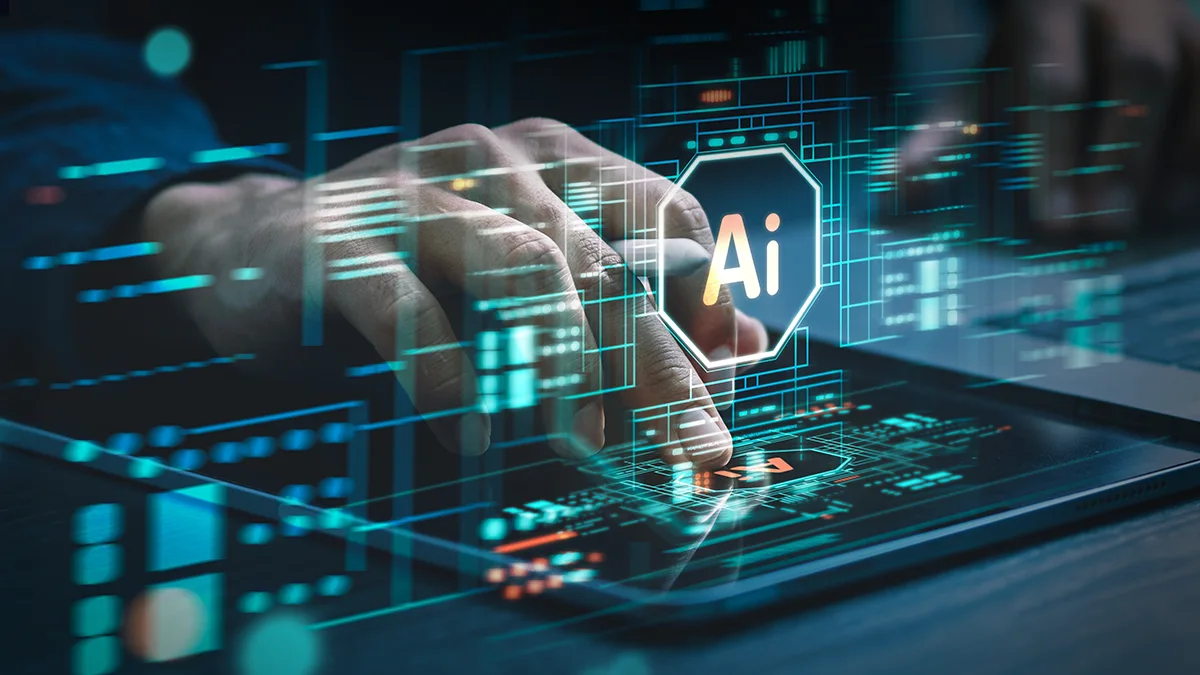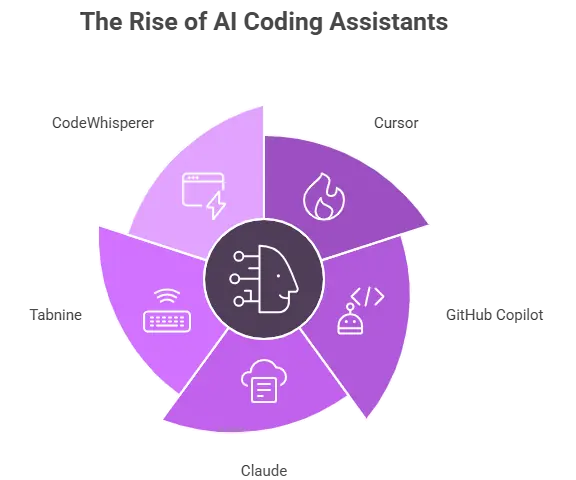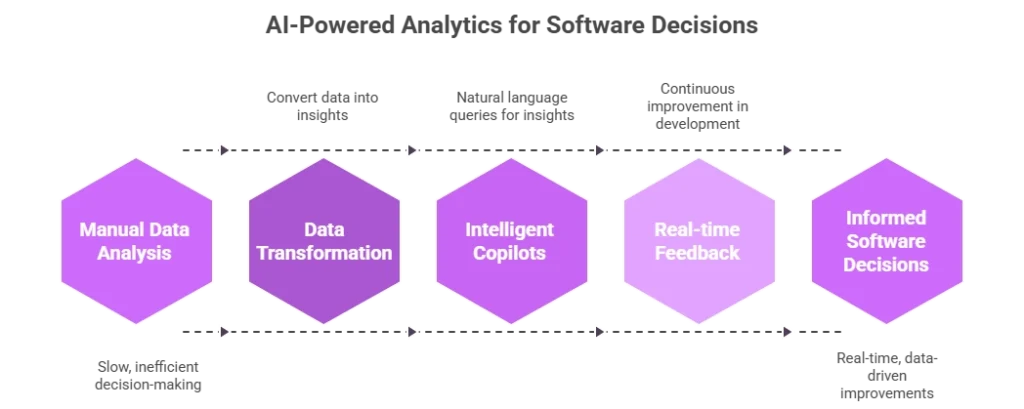AI in software development – boosting productivity or just a buzzword?

Artificial intelligence is changing how we build software – but not always in the ways we expect. For the past two years, engineering teams have been flooded with new tools promising to automate, accelerate, and improve every part of the software development lifecycle. The question is no longer whether AI is being used in software engineering, but whether it’s actually making developers and organizations more productive?
The data is encouraging but nuanced. According to the LeadDev AI Impact Report 2025, 66% of engineering teams have already adopted AI tools in production, and 59% say these tools make them more productive [1]. Gartner forecasts that by 2028, over 80% of enterprise software will embed generative AI features [2]. McKinsey, meanwhile, estimates that AI could generate up to $4.4 trillion annually in global productivity gains, with software development among the top beneficiaries [3].

But hype alone doesn’t ship code. To understand the true picture, we need to look closely at the tools shaping the modern development process-where they’re delivering measurable impact, where gaps still exist, and how organizations can capture real value.
AI in software development: coding assistants – the everyday revolution
Among all AI-driven innovations, coding assistants have had the most visible effect on daily work. The relationship between AI and software development is becoming increasingly intertwined, with AI and machine learning transforming and enhancing software engineering processes. Tools such as Cursor, GitHub Copilot, Claude, Tabnine, and CodeWhisperer are redefining what writing code means. In many organizations, these assistants are now as common as the text editor itself.
Cursor currently leads in enterprise adoption, used by 45% of teams surveyed in LeadDev’s study [1]. Unlike earlier autocomplete engines, Cursor understands project context – it can search across files, refactor intelligently, and generate consistent code snippets aligned with architecture guidelines. As an AI driven solution, Cursor automates and democratizes software creation, enabling both technical and nontechnical users to build advanced AI-powered applications. It eliminates large portions of boilerplate code and repetitive tasks that previously consumed developer time. A senior engineer can now produce in minutes what once took hours. This shift allows development teams to dedicate more effort to complex problems like optimization and system integration.
GitHub Copilot remains the benchmark. Built on advanced machine learning algorithms trained on billions of lines of public code, it delivers remarkably accurate code completion and code suggestions based on natural language descriptions. Copilot has transformed the process of code writing by providing autocompletion, error detection, and code generation, making developers more productive. Organizations using Copilot report measurable results: a 25–35% improvement in developer velocity and a 20% reduction in time spent on debugging. These numbers are not only impressive – they are reshaping hiring and project planning assumptions. Instead of focusing purely on coding hours, teams can now measure throughput and creativity.
Claude, Anthropic’s large language model, represents the next evolution of AI in software development. Rather than generating code line-by-line, Claude comprehends entire repositories. It reads documentation, comments, and project histories to propose refactors and explain system logic. For example, in one R&D environment, Claude analyzed 80,000 lines of legacy code, summarizing architecture dependencies and identifying potential performance bottlenecks in under an hour-a task that would have taken a human developer several days. Claude and similar AI tools also help identify and fix coding errors, improving software quality and streamlining development workflows. This capability makes Claude particularly useful for organizations that maintain large, complex systems or need to onboard new developers quickly.
Tabnine and CodeWhisperer focus on enterprise security and compliance. Tabnine runs locally or in private clouds, ensuring sensitive code never leaves the company perimeter, while CodeWhisperer integrates directly into AWS environments, generating context-aware functions tied to cloud services. These tools can generate entire functions from natural language inputs, further automating routine coding tasks. Both tools demonstrate how AI assistants are adapting to corporate realities, where intellectual property protection is as important as productivity.
These tools are shifting the balance of effort. They assist developers by automating code generation, suggesting code snippets, and streamlining the development process. Instead of spending time on repetitive tasks, engineers are focusing on architecture, security, and innovation. In many ways, they are redefining what it means to practice software engineering. The introduction of generative AI into the daily workflow represents the most significant paradigm shift since the rise of cloud computing – and its implications are still unfolding.

Testing and QA: AI tools that strengthen quality
Quality assurance is a cornerstone of the software development process, and AI is quietly transforming it. Testing once required armies of manual testers or complex scripts, but modern AI-driven testing tools can automate these steps, learning and improving with every cycle. AI excels at automating repetitive tasks such as test case creation and execution, significantly increasing efficiency and freeing up QA teams to focus on more complex issues.
Solutions like Testim, Mabl, CodeRabbit, and Amazon Q use machine learning models to identify patterns in historical data and create dynamic test cases. Instead of relying solely on human-written tests, AI continuously adapts test coverage based on real-world user behavior. This means critical edge cases are discovered earlier in the development cycle. LeadDev’s survey notes that 57% of organizations have adopted AI in QA, and 23% report reduced technical debt after doing so [1].
CodeRabbit, for example, combines generative AI with automated code reviews to flag potential security vulnerabilities and logic flaws before deployment. It even provides recommendations for code refactoring and can automatically write test scripts for newly committed features. Companies that implemented AI-driven QA tools reported up to 35% faster regression testing and a 20% decrease in post-release bugs. Mabl and Testim enhance this with self-healing tests-scripts that automatically update when UI or API structures change, reducing maintenance costs.
In addition, AI-driven tools now integrate predictive analytics. They can estimate the probability of a new release introducing performance degradation or new bugs. By analyzing historical data, they enable development teams to plan release windows with greater confidence. These improvements don’t just raise software quality – they transform risk management. Software development becomes proactive rather than reactive. For organizations operating at scale, this automation translates directly to fewer outages, improved customer satisfaction, and lower operational costs. By streamlining and enhancing development processes, AI integration ensures that QA and testing are more efficient and effective throughout the software lifecycle.
Project management and engineering coordination
AI is also transforming how engineering organizations plan and coordinate work. Project management is no longer about static dashboards and manual updates. Today’s AI-powered tools LinearB, Asana Intelligence, and Jira’s AI automation suite analyze data from commits, branches, and issues to provide predictive insights. By analyzing user data, these tools can further improve project planning and coordination, ensuring that teams are working with the most relevant and actionable information.
Imagine being able to forecast sprint velocity not by estimation, but by machine learning. AI can identify where bottlenecks are forming, which pull requests are stalled, and even where communication gaps exist between teams. Gartner predicts that by 2026, 70% of software organizations will use AI to inform project planning decisions [2]. This level of visibility turns project management into an exercise in data-driven optimization.
AI-driven analytics also enhance strategic forecasting. For instance, some organizations use AI to model the impact of changing project requirements mid-cycle. By simulating the development cycle, AI tools predict delivery delays or resource shortages before they occur. This enables teams to adjust priorities proactively.
The adoption of AI in project management is still in early stages, but its potential is clear: fewer missed deadlines, less burnout, and more transparent collaboration across departments.

Data, analytics, and decision support
AI’s role in software engineering extends well beyond the code editor. Data analysis tools powered by AI are changing how leaders make decisions about products and infrastructure. Platforms like Databricks, Glean, and Perplexity AI use machine learning and natural language processing to transform vast streams of technical data into actionable insight. The development and deployment of these AI-powered analytics tools rely heavily on programming languages, which serve as the foundation for implementing and optimizing AI models within these platforms.
For example, AI-driven analytics can correlate user behavior with system performance, helping teams prioritize optimizations that actually improve user experience. In one fintech case study, AI models analyzing customer usage patterns reduced unnecessary computation loads by 18%, saving both infrastructure cost and response time.
Google Gemini and OpenAI’s GPT-4 Turbo take this further by serving as intelligent copilots for decision-making. They allow teams to query logs, incident data, and telemetry in natural language-bridging the gap between technical and business stakeholders. Instead of manually digging through metrics, leaders can ask, “How did deployment latency change after the last release?” and get immediate, visualized responses.
The rise of AI systems in analytics means that software decisions are now informed by real-time feedback loops. This enables continuous improvement throughout the software development lifecycle, and it reinforces the importance of integrating AI seamlessly into every stage of the development process.
Integration and security: the silent enablers
Integration and security may not dominate headlines, but they are essential to trustworthy AI adoption. Many companies underestimate the risks of using ai generated code without proper validation. As AI becomes more embedded in workflows, ensuring compliance and safeguarding intellectual property become top priorities. Integrating AI into software development offers enhanced productivity, improved security, and faster project completion by automating tasks like code review and debugging.
Tools like GitLab Duo, Amazon Bedrock, and n8n help enforce governance by scanning codebases for security vulnerabilities and managing model access. These AI technologies offer observability layers that track what AI models generate, when, and under which context. In regulated industries, such traceability is critical.
LangChain and Zapier AI focus on connecting systems, enabling smooth system integration between AI components and traditional software infrastructure. They automate repetitive tasks like data synchronization, report generation, and code deployment, freeing up developers for more complex tasks. When used correctly, they reduce human error while ensuring system stability.
AI in software security is also evolving rapidly. Tools can now monitor repositories for potentially exposed secrets or unsafe dependencies introduced through ai generated code. This layer of automation ensures compliance with standards such as ISO 27001 and SOC 2 without additional human overhead.

The role of outsourcing and R&D staff augmentation
Adopting AI tools effectively requires expertise in computer science, machine learning, and practical software engineering. Many organizations lack this combination in-house, especially when scaling quickly. That’s where outsourcing and R&D staff augmentation enter the picture, enabling organizations to leverage emerging technologies such as AI for software development.
Partnering with experienced AI development teams allows companies to accelerate implementation without overloading internal staff. These partnerships are particularly valuable for integrating AI-driven tools into legacy systems or establishing governance around AI-assisted code reviews and testing pipelines.
By collaborating with external specialists, organizations can automate repetitive tasks, improve code quality, and shorten release cycles while retaining control over business strategy. The model is simple: let outside experts handle AI system design and integration so that in-house teams can focus on innovation and differentiation. This hybrid approach has already become a best practice in ai in software development.
From generative to cognitive AI in software engineering
The next phase of AI innovation will move from generative to cognitive systems. Tools that don’t just produce code, but understand the intent behind it and demonstrate AI’s ability to handle complex software engineering tasks such as high-level design, refactoring, and debugging. Cursor already demonstrates this shift, learning from developers’ habits and improving its accuracy over time. Claude can interpret architectural principles and recommend improvements that align with performance and scalability goals.
Gartner forecasts that by 2030, AI-driven environments will automate 70% of routine coding tasks [2]. McKinsey predicts that fully integrated gen AI platforms will reduce time-to-market for software by 30% [3]. Combined with machine learning models capable of continuous self-optimization, these technologies will make software development more adaptive and self-correcting. The result: faster innovation and better resilience, but also potential challenges as the industry adapts to new workflows and redefines the role of software engineers.

Yet even as AI automates coding and testing, human creativity remains central. Developers will evolve into system designers and AI orchestrators: roles focused on problem solving, architectural design, and ethical oversight. The unique problem solving skills, creativity, and deep understanding of user needs that software engineers possess cannot be fully replicated by AI. This new era of software engineering will reward teams that combine deep technical insight with strategic thinking. In the end, AI’s ability to enhance decision-making and code generation will be only as powerful as the people guiding it.
Future outlook: beyond tools toward transformation
The trajectory is clear: AI tools are no longer isolated assistants but parts of unified ecosystems. Future IDEs will include AI for debugging, QA, deployment, and documentation, making the entire development process continuous and intelligent.
Expect also a greater emphasis on compliance and explainability. AI-driven testing tools will justify their findings. Generative models will store versioned reasoning chains, enabling full auditability of AI decisions. These improvements will make AI not only faster, but safer for enterprise-scale adoption.
The software engineering landscape will also see new roles: AI system architects, data ethicists, and prompt engineers. The job market will evolve, not contract. AI eliminates low-value repetitive work, but it amplifies demand for advanced reasoning, architecture, and cross-disciplinary collaboration. Ultimately, AI in software development will not replace humans-it will redefine what productivity means.
Conclusion: turning potential into measurable impact
AI in software development is no longer speculative, it’s measurable. From code generation to automated QA, from analytics to project management, these tools have proven their ability to streamline workflows and elevate software quality. Cursor, Copilot, and Claude exemplify how artificial intelligence can amplify human talent.
The challenge ahead lies in governance, metrics, and integration. Organizations must establish clear measurement frameworks and responsible adoption guidelines. The combination of AI systems, machine learning algorithms, and human oversight will determine whether AI’s ability becomes a sustained advantage or another passing trend.
Transition Technologies PSC helps enterprises navigate this transformation by integrating AI responsibly into their R&D and software engineering operations. Through outsourcing, R&D staff augmentation, and custom AI implementation, we help clients leverage AI effectively, automate repetitive tasks, and build scalable, secure solutions that enhance software quality without increasing complexity.
AI doesn’t make developers obsolete – it makes them indispensable to a new, data-driven world of creativity and performance. That’s the real productivity revolution-making software development smarter, faster, and better for everyone.
References
[1] LeadDev, AI Impact Report 2025
[2] Gartner, Generative AI Predictions 2024–2028
[3] McKinsey & Company, State of AI 2024 and The Economic Potential of Generative AI
